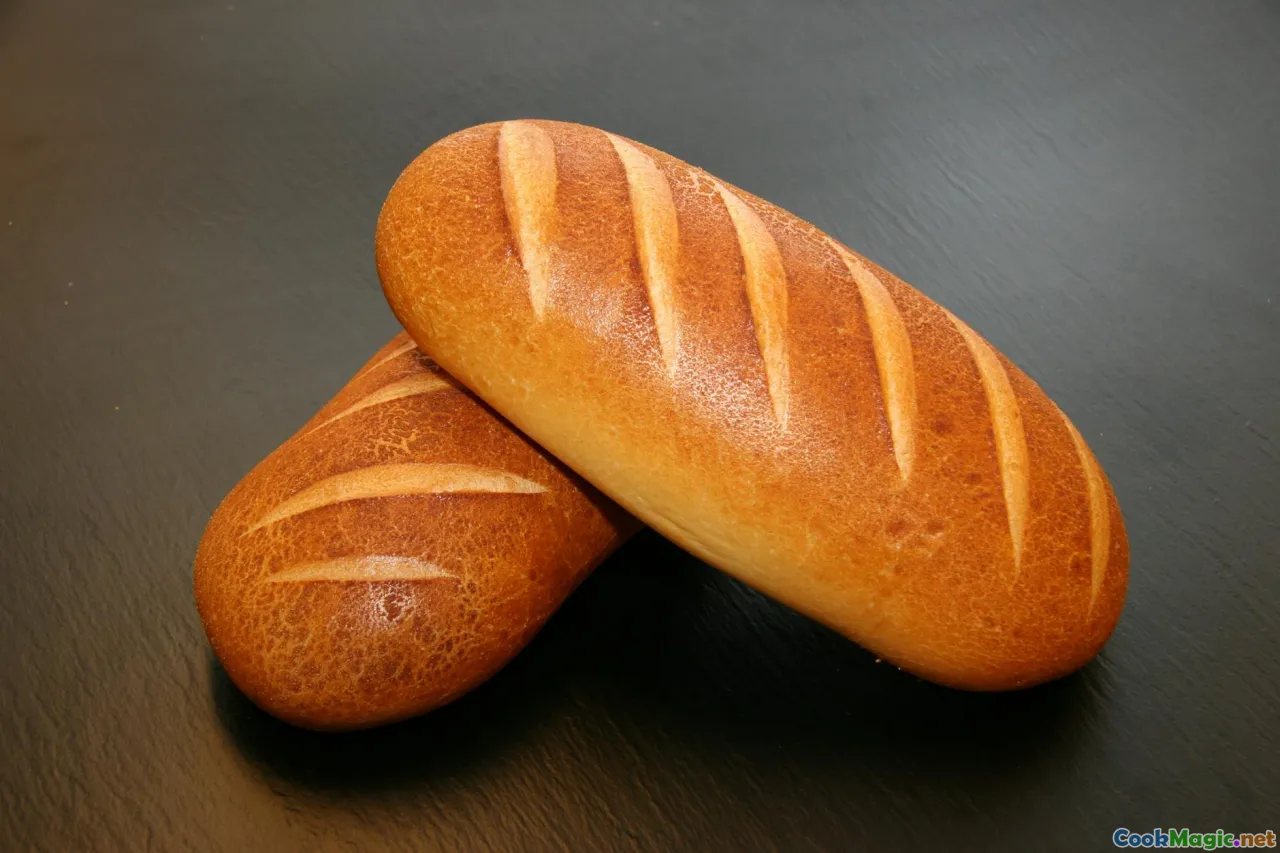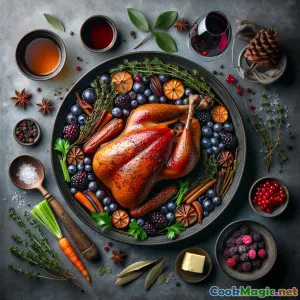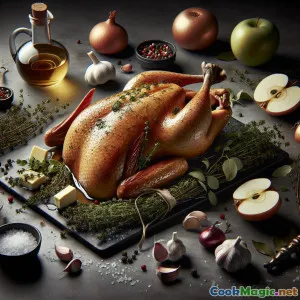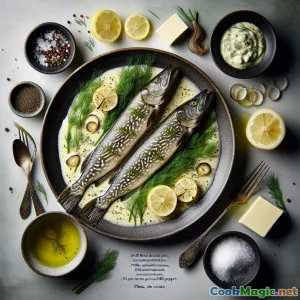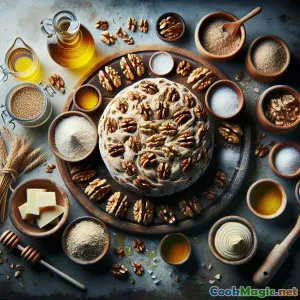
Pain de Campagne au Seigle et Noix de Podhale Émeraude
(Emerald Podhale Rye & Walnut Country Bread)
(0 Avis)0
3,332
juillet 17, 2025
Signaler un problème
Ingrédients
-
300 grams Farine de seigle
(Farine de seigle moulue à la pierre ou seigle complet)
-
200 grams Farine de blé pour pain
(Farine blanche de force pour la structure)
-
100 grams Noix cassées
(Haché grossièrement)
-
2 teaspoons Graines de carvi
(Optionnel mais traditionnel)
-
7 grams Levure sèche active
(1 sachet standard)
-
10 grams Sel marin
(Sel de mer fin préféré)
-
1 tablespoon Miel
(Apporte de la profondeur et une douceur subtile; le sirop d'erable peut servir de substitut.)
-
350 ml Eau tiède
(Environ 38–40°C pour activer la levure.)
-
1 tablespoon Huile d'olive
(Aide à préserver l'humidité et la couleur de la croûte)
(Farine de seigle moulue à la pierre ou seigle complet)
(Farine blanche de force pour la structure)
(Haché grossièrement)
(Optionnel mais traditionnel)
(1 sachet standard)
(Sel de mer fin préféré)
(Apporte de la profondeur et une douceur subtile; le sirop d'erable peut servir de substitut.)
(Environ 38–40°C pour activer la levure.)
(Aide à préserver l'humidité et la couleur de la croûte)
Nutrition
- Portions: 8
- Taille de portion: 1/8 de miche (environ 75 g)
- Calories: 224 kcal
- Carbohydrates: 39 g
- Protein: 6 g
- Fat: 5 g
- Fiber: 4 g
- Sugar: 2 g
- Sodium: 295 mg
- Cholesterol: 0 mg
- Calcium: 22 mg
- Iron: 1.4 mg
Instructions
-
1 - Activer la levure:
Mélangez la levure et le miel (si vous en utilisez) dans de l’eau tiède. Laissez reposer pendant 10 minutes jusqu’à ce que la mousse se forme.
-
2 - Combiner les ingrédients secs:
Dans un grand bol, mélangez la farine de seigle, la farine à pain, le sel et les graines de carvi (si vous en utilisez).
-
3 - Pâte à Modeler:
Versez le mélange de levure et l'huile d'olive (si vous en utilisez) sur les ingrédients secs. Mélangez à l'aide d'une cuillère robuste jusqu'à ce que le tout soit homogène.
-
4 - Ajoutez des noix, pétrissez:
Incorporez les noix. Placez la pâte sur une surface légèrement farinée et pétrissez jusqu'à ce qu'elle soit lisse (7–10 minutes).
-
5 - Première Levée:
Placez la pâte dans un bol légèrement huilé. Couvrez et laissez lever dans un endroit à l'abri des courants d'air jusqu'à ce qu'elle double de volume (environ 2 heures).
-
6 - Façonner et deuxième levée:
Dégazez la pâte et façonnez-la en boule. Déposez-la sur du papier cuisson ou dans un banneton fariné. Couvrez et laissez lever jusqu'à ce qu'elle gonfle, environ 1,5 heure.
-
7 - Préchauffer le four:
Pendant la dernière phase de levée, préchauffez le four à 230°C (446°F) avec une cocotte en fonte à l'intérieur.
-
8 - Inciser et cuire au four:
Transférez délicatement la pâte dans la cocotte en fonte chaude; saupoudrez d'un peu de farine supplémentaire et faites une incision sur le dessus. Couvrez et faites cuire 35 minutes, puis découvrez et terminez la cuisson 10 minutes pour obtenir une croûte profonde.
-
9 - Refroidir et Servir:
Sortez le pain et laissez-le refroidir sur une grille métallique pendant au moins 30 minutes avant de le couper pour finaliser le développement de la texture.
Mélangez la levure et le miel (si vous en utilisez) dans de l’eau tiède. Laissez reposer pendant 10 minutes jusqu’à ce que la mousse se forme.
Dans un grand bol, mélangez la farine de seigle, la farine à pain, le sel et les graines de carvi (si vous en utilisez).
Versez le mélange de levure et l'huile d'olive (si vous en utilisez) sur les ingrédients secs. Mélangez à l'aide d'une cuillère robuste jusqu'à ce que le tout soit homogène.
Incorporez les noix. Placez la pâte sur une surface légèrement farinée et pétrissez jusqu'à ce qu'elle soit lisse (7–10 minutes).
Placez la pâte dans un bol légèrement huilé. Couvrez et laissez lever dans un endroit à l'abri des courants d'air jusqu'à ce qu'elle double de volume (environ 2 heures).
Dégazez la pâte et façonnez-la en boule. Déposez-la sur du papier cuisson ou dans un banneton fariné. Couvrez et laissez lever jusqu'à ce qu'elle gonfle, environ 1,5 heure.
Pendant la dernière phase de levée, préchauffez le four à 230°C (446°F) avec une cocotte en fonte à l'intérieur.
Transférez délicatement la pâte dans la cocotte en fonte chaude; saupoudrez d'un peu de farine supplémentaire et faites une incision sur le dessus. Couvrez et faites cuire 35 minutes, puis découvrez et terminez la cuisson 10 minutes pour obtenir une croûte profonde.
Sortez le pain et laissez-le refroidir sur une grille métallique pendant au moins 30 minutes avant de le couper pour finaliser le développement de la texture.
En savoir plus sur: Pain de Campagne au Seigle et Noix de Podhale Émeraude
Introduction
Podhale Rye and Walnut Rustic Bread is a tribute to rustic Eastern European country loaves, inspired by the earthy harvests and simple but profound home baking traditions of the Podhale region in southern Poland. This bread encapsulates Old World culinary wisdom—a time when bread was nourishment, centerpiece, and pride for rural families across Polish highlands.
The heady aroma of rye, pulsing with nutty sweetness from walnuts and a brush of caraway, harkens back to bread you’d encounter in mountain village markets or alongside cheese and mushroom stews shared at timber-clad inns. What makes this recipe unique is its blend of rich rye with wheat, providing an accessible crumb for modern bakers without losing Old Country character. The addition of walnuts not only amplifies texture but harnesses Podhale’s tradition of foraging for nuts and herbs.
Tips, Notes & Substitutions
- Flour: Always use the best-quality rye flour you can get; stone-ground gives an authentic, earthy taste and solid nutrition. In a pinch, dark rye can be blended with all-purpose, but ratios may need tweaking as rye absorbs more moisture.
- Nuts: Walnuts should be coarsely chopped; their visiting crunch provides dynamic mouthfeel in each bite. If walnuts aren’t available, hazelnuts (common to Carpathia) are a tasty substitute.
- Crust: For an extra crisp, crackly crust, bake the bread in a pre-heated Dutch oven and leave the lid off for the final 10 minutes for deeper color—and a mesmerizing aroma.
- Salt & Sweeteners: Finer salt disperses better; honey isn’t vital but disguises the sometimes-acidic rye and boosts browning. Maple syrup lends a smoky undertone.
- Caraway: While optional, caraway is time-honored in Central European rye loaves and lends an unmistakeable tingle and deformal bread-smell many Eastern Europeans associate with home.
History & Cultural Significance
In the foothills of the Tatra mountains, bread is more than a daily bake. Once a way of life for highlanders—shepherds, cheese makers, artisans—the Podhale region’s dark breads fueled their hard, windy, communal living. Grain had to be stretched; supplements like mashed potato, seeds, and sometimes whatever orchard windfall (namely walnuts) could enrich sparse cupboards. Sundays and harvest feasts still see loaves cross icons and prayer candlelight, a centerpiece of gratitude and togetherness.
This take on the Podhale loaf is a blend of tradition and modern comfort—combining enough wheat flour for a soft crumb with distinct rye tang, then adding encased, roasted walnuts that offer unexpected excitement as you slice through.
Personal Thoughts & Serving Ideas
This bread, while sublime warm and buttered, reaches its zenith when paired with smoked cheese (try Oscypek), thick honey, or cold mountain trout pâtés. Leftover slices transform into hearty toast or grids of rye-and-walnut salads. In winter, I love it next to borscht; in summer, simply torn apart under alpine wildflower meadows.
What’s magical is how the nuts caramelize as the bread bakes, scenting the crust and giving a depth not found in mass-produced loaves. It’s as deeply nested in Polish tradition as it is friendly to modern, health-focused kitchens that value fiber, ancient grains, their slow nutrition, and their careful stories.
Final Note
Bake this bread not just for its taste, but because its aroma alone can unite friends and neighbors for comfort and good talks. Both simple and sophisticated, the Podhale Rye and Walnut Rustic Bread invites you to slow down and savor.

